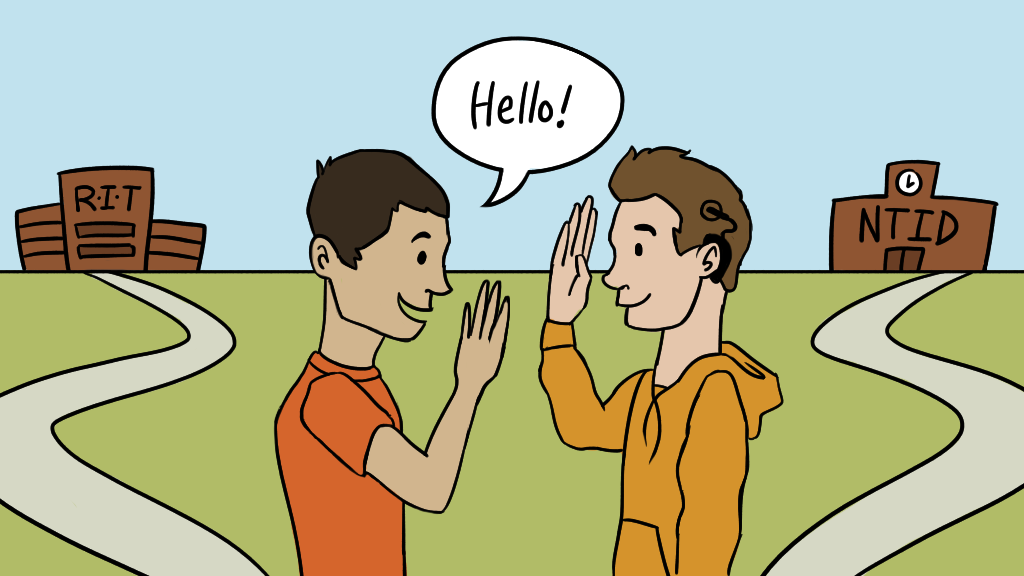College is a period where everyone attempt to "find" themselves, typically branching off into groups of people with similar interests. This is common among college students, but for a diverse campus like RIT there is a hidden problem that goes almost unnoticed.
Containing a mix of hearing, hard-of-hearing (HoH) and Deaf students, RIT is a particularly unique campus for college students. This makes RIT stand out, obviously, but just because it has a diverse student body doesn’t mean that there is much social interaction between the Deaf and hearing students.
Before I go any further, I want to point out that this article is not meant to bash either side but rather figure out what is causing this issue.
Ruth Starr, a fourth year Museum Studies and Interpreting major at RIT, feels strongly about this issue.
"It's not that I noticed they haven’t interacted with each other, they interact with their own group,” Starr says. “There can be a natural socialization and a structural aspect to it. Most of the time, when students arrive to RIT, they don’t usually have an automatic thought of who they will meet. With hearing students, usually a lot of them haven’t been exposed with Deaf people so they don’t really expect there to be a huge Deaf community here.”
It is not the students' fault that this separation happens, as the structure of the college perpetuates the issue. It all starts with the Summer Vestibule Program (SVP), which is NTID's orientation, and RIT's orientation as they both are done at separate times. From there, the NTID students typically already have their social groups as SVP is before RIT’s orientation. When orientation begins for RIT, the students usually find their social groups within that week and because of this, there isn’t much interaction between the two colleges.
“NTID also seems like a separate college at times, as they have their own separate student government structure and clubs,” Star adds. There is noticeable separation as well, as NTID is separated from the rest of the colleges here at RIT. “NTID is a safety blanket for Deaf students,” Starr says, “but it allows the students to be more independent which is helpful for the transition from NTID to RIT.”
NTID is a safety blanket for Deaf students.
Academically, there seems to be no problem in terms of the separation as the system is good enough to manage the mainstream setting. Outside of academics, there is still a problem. It takes a cultural value of communication access across campus to allow everyone to be included. The social aspect of this issue is that you cannot mandate everyone to learn sign language or any spoken language.
“It’s really a paradigm shift that’s going on," Starr says. "Everyone here is an individual and everyone focuses on themselves first. It’s really an ‘I need to learn for myself’ attitude around here.”
RIT is still figuring this issue out, and they have no model to look at while mainstream K-12 schools have other mainstream schools to compare with. There are programs on campus, however, that work to unify both colleges. No Voice Zone is a weekly event where students can go and learn sign language from other students.
“It’s good because it focuses on the social aspect and shows that the community of the deaf isn’t so different from the hearing community,” Starr explains. The problem with No Voice Zone is that it is almost the only solution on campus. Additionally, the program itself has flaws. It is sometimes unclear to students whether NVZ is a program only for Deaf students, or for both Deaf and hearing students. Programs like NVZ need to be promoted more to encourage students who want to learn sign language but don't actually know about the program.
Other things that could help with connecting the two campuses would be more connection with the clubs and student congress.
“I think there are more opportunities for collaboration here. There are many religious and cultural clubs here, but also a Deaf counterpart as well,” Starr brings up. “I understand Deaf people want to connect with other Deaf people, so there shouldn’t be any destruction of the clubs and forcing them to combine, but rather collaboration between the two clubs.”
As there is a lot of improvement that needs to be done with this issue, it isn’t just something one side should be fully invested in. It will take an equal effort on both sides for this issue to be solved.
“It isn’t always automatically apparent until you start to look for it, then you will notice the separation,” Starr says.








